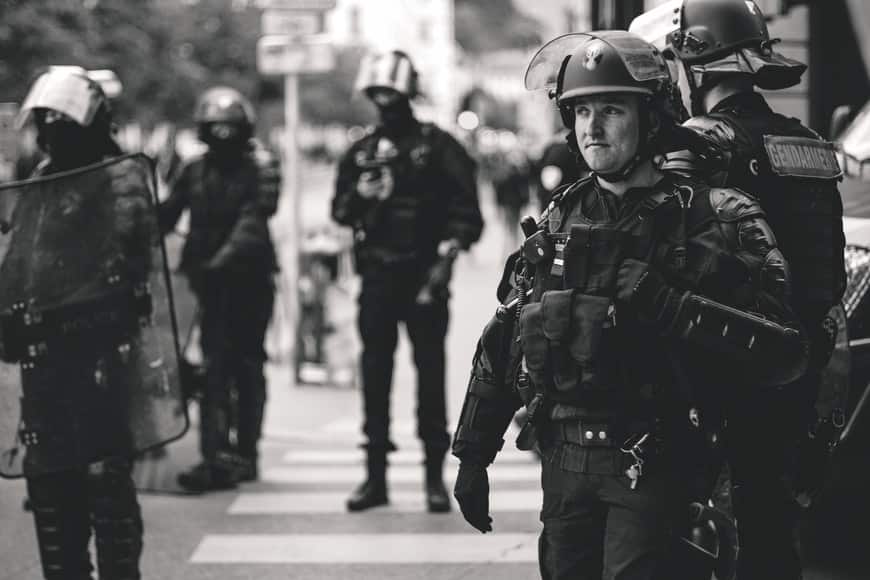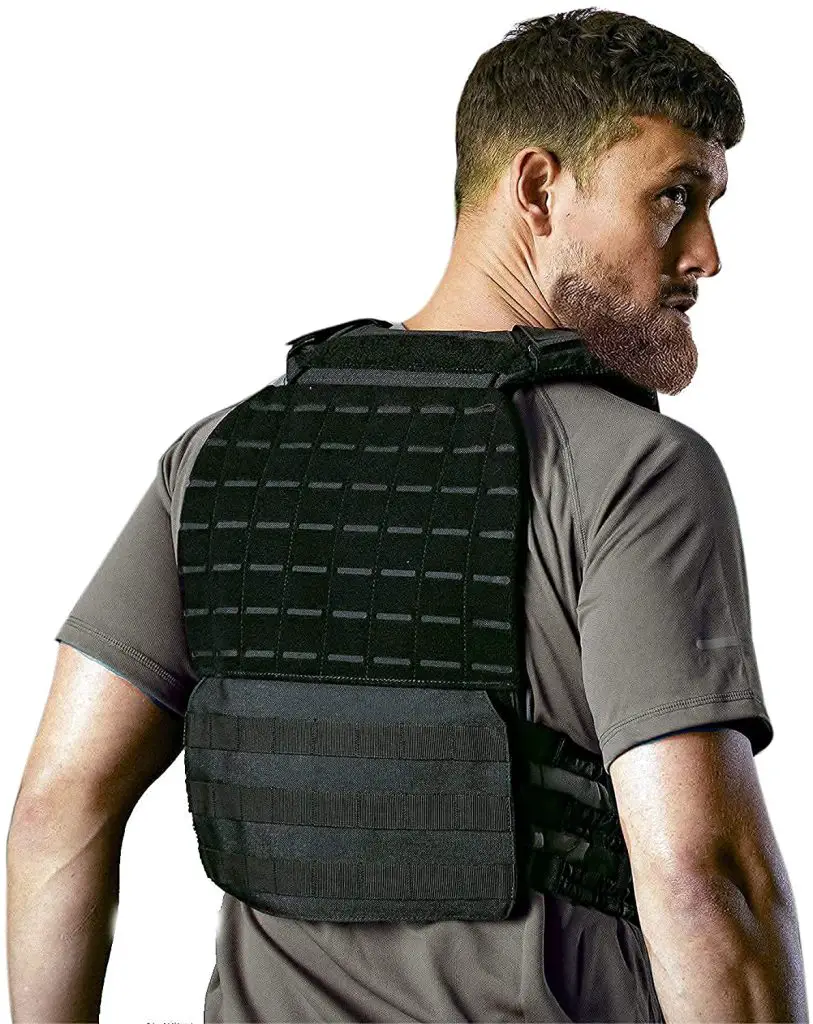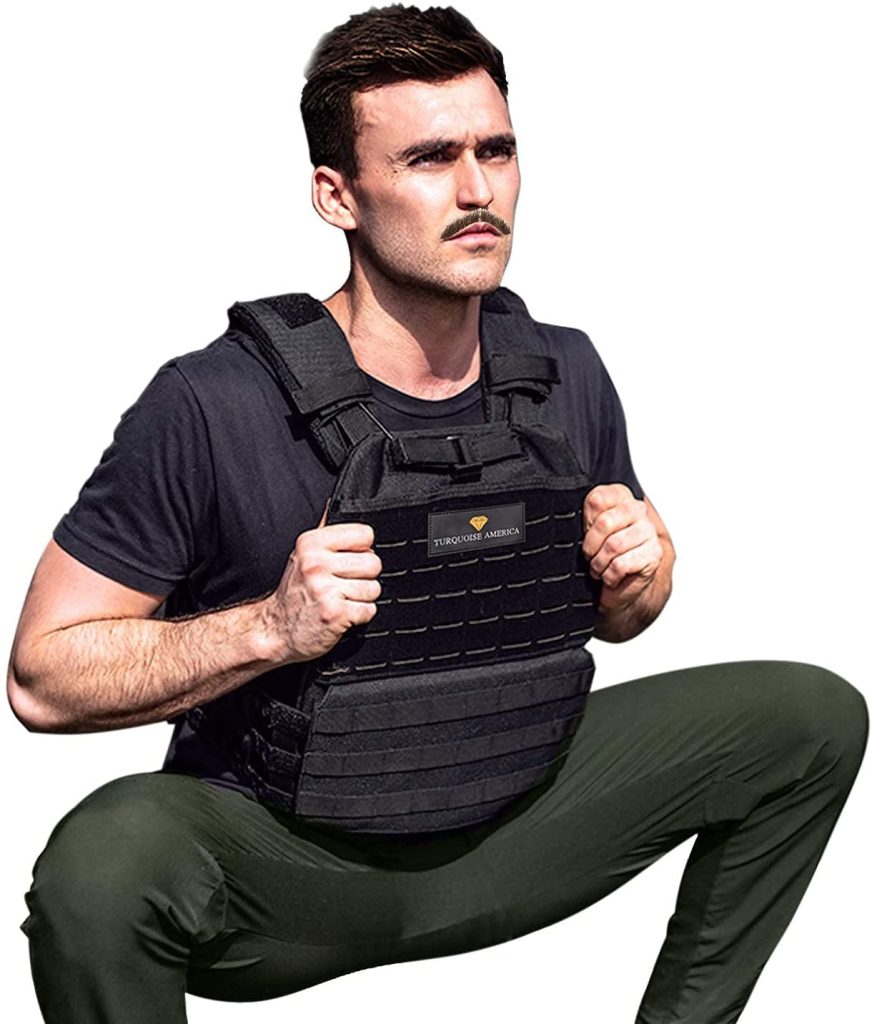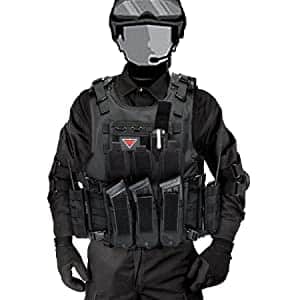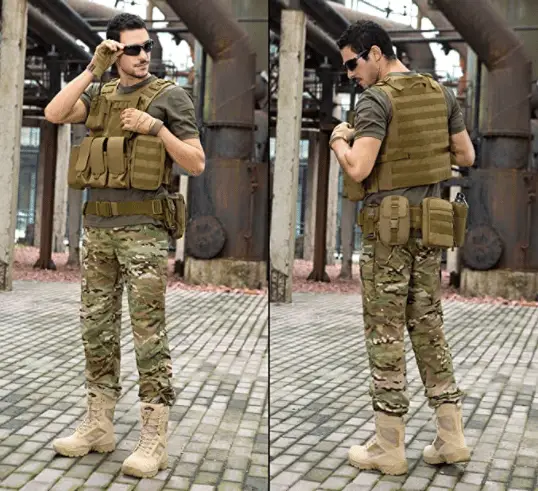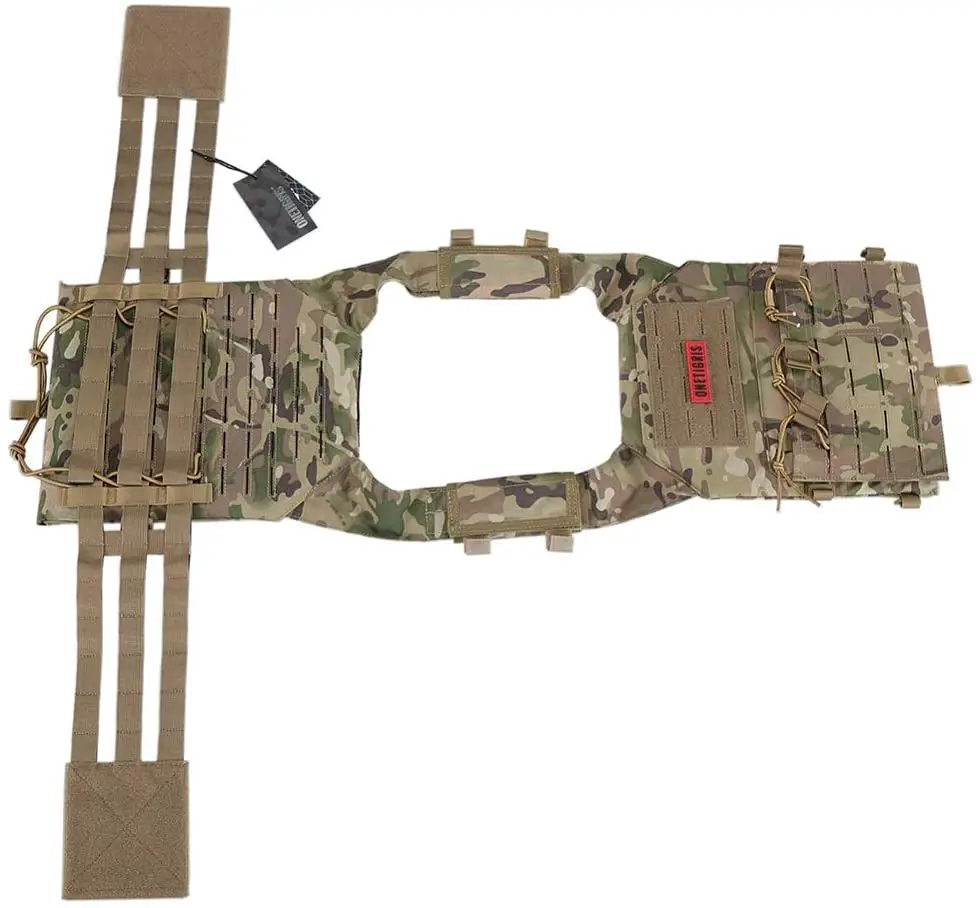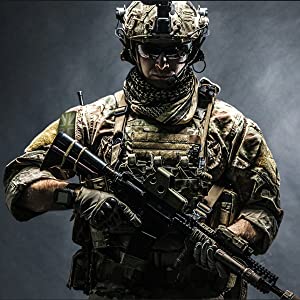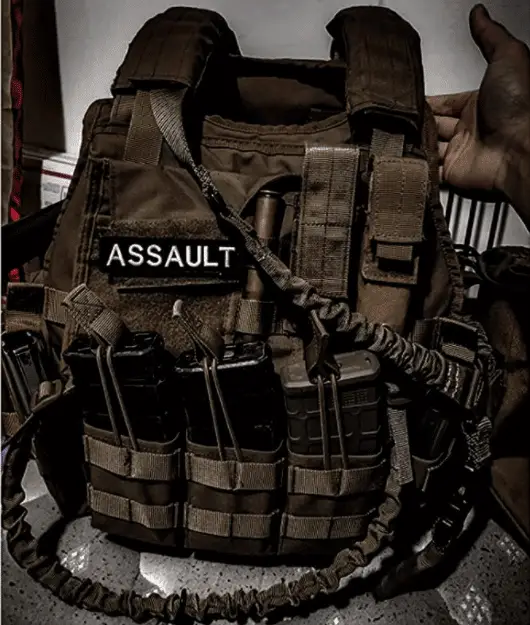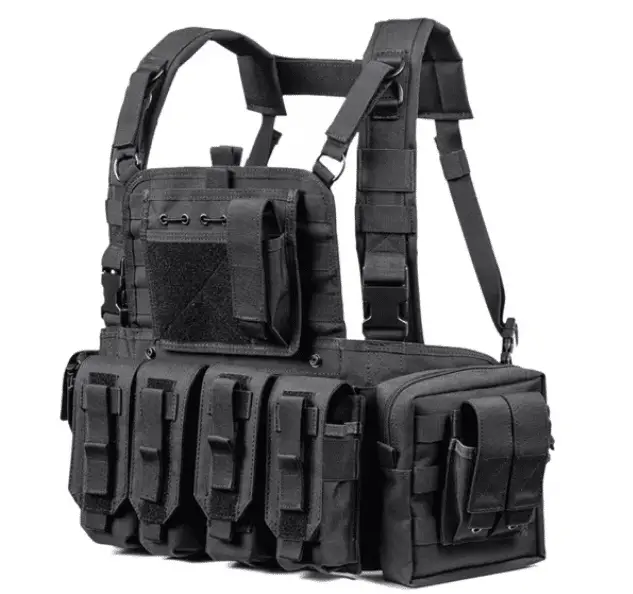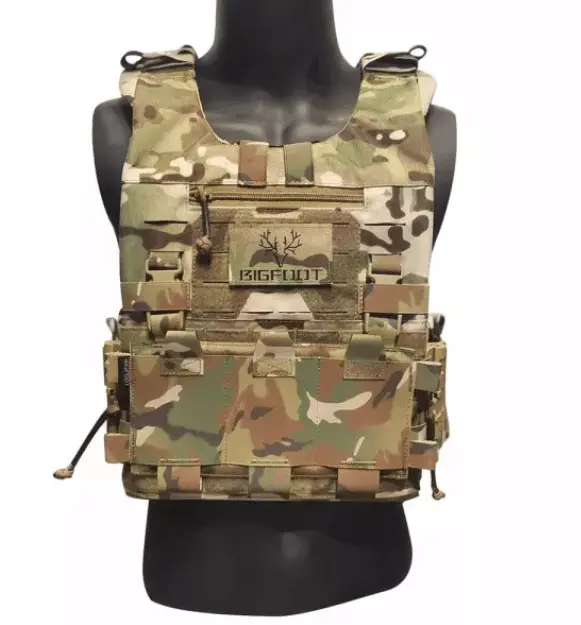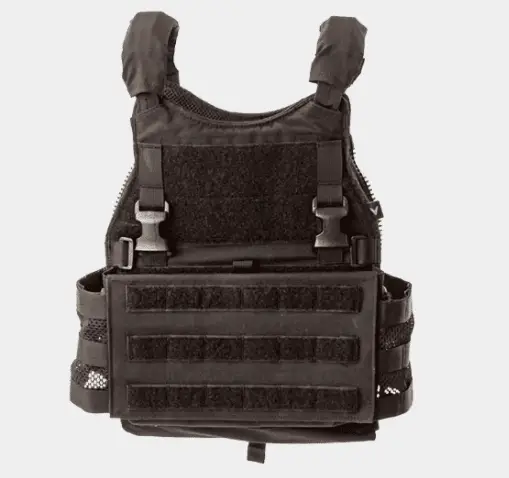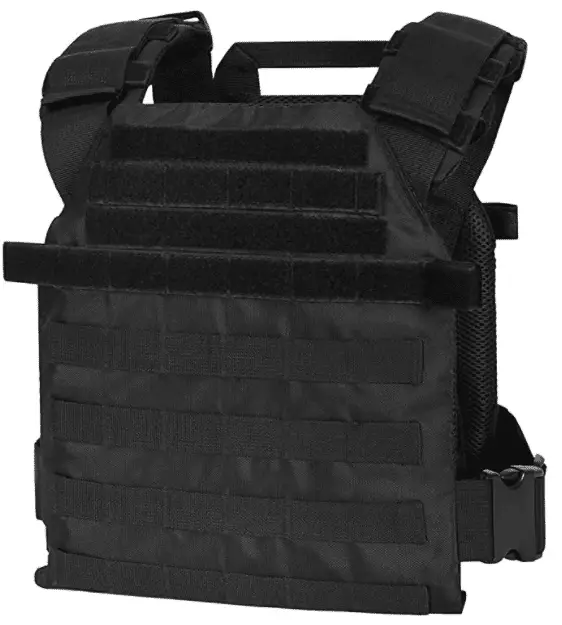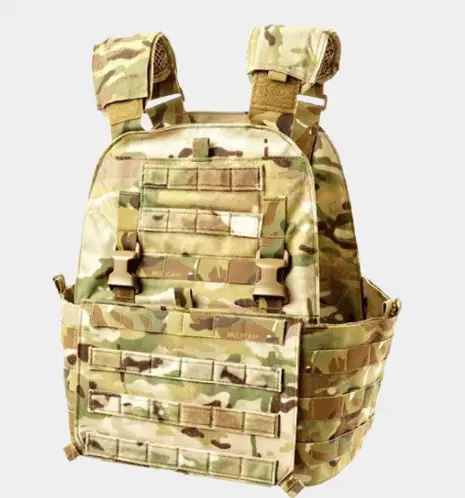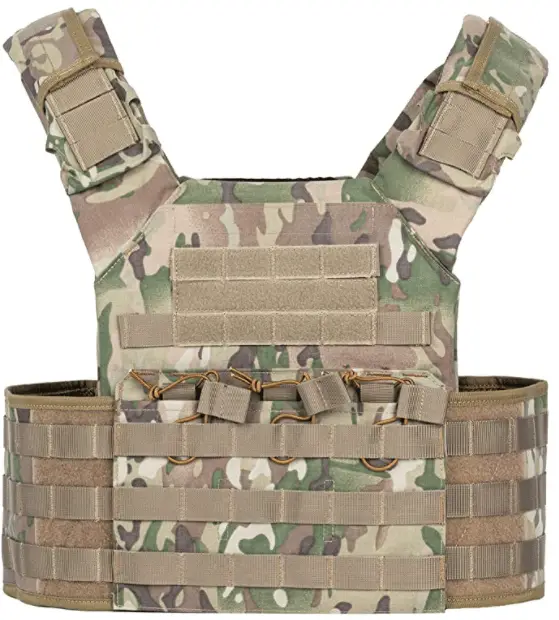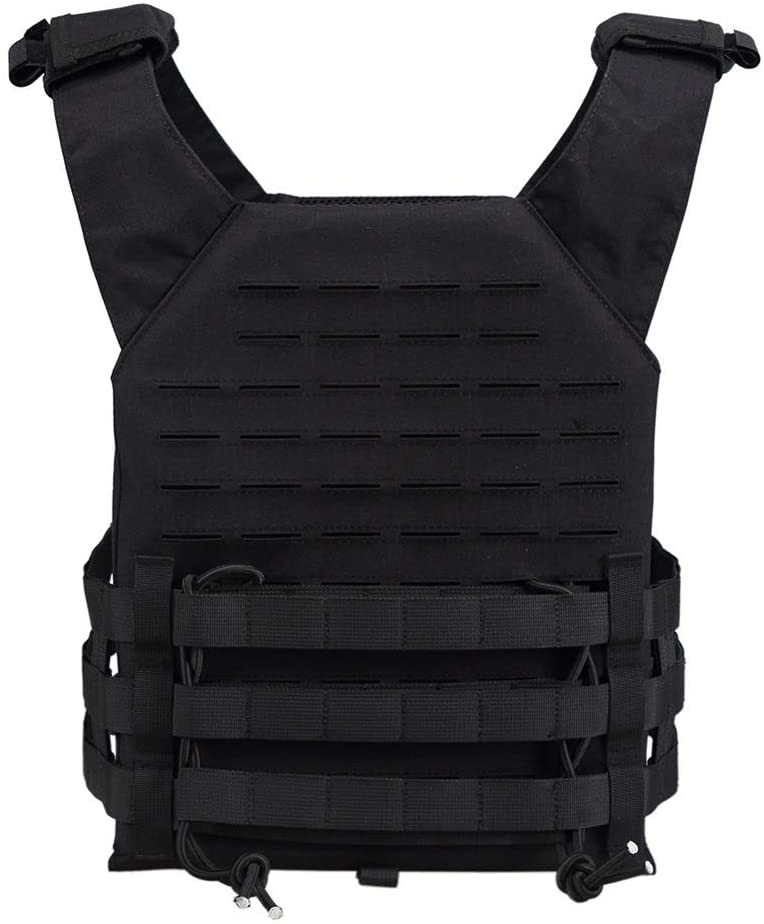With so many things going on these days, it’s not surprising to find lots of people taking home and family security more seriously. And if you’re one of those people, you’ve probably considered getting your own plate carrier.
If you’ve already done your research and the options you found overwhelmed you, don’t worry. Picking the best plate carrier is never an easy process, particularly for people with no military background.

What Are Plate Carriers?
A plate carrier is a kind of protective vest that lets you load plates of different protective levels. It comes with pouches and pockets for that purpose.
Now, you might be wondering, are plate carriers similar to ballistic vests?
Well, they’re quite similar since plate carriers are a type of ballistic vest. Kevlar and bulletproof vests fall under the same category too.
However, when you compare a plate carrier to those vests, you’ll find it more adaptable and a bit heavier.
Plate carriers are relatively new. In fact, they’ve only made their way into soldiers’ standard equipment in the last 30 to 40 years. Their early versions were flak vests. In World War II, bombers used them to halt shrapnel from the German 88 guns.
The modern plate carriers came into reality during the 1980s. From there, they went through a lot of upgrades with some of them being ultralightweight and able to prevent armor-piercing ammunition from getting through.
The Purpose of Plate Carriers
The most common use of plate carriers is for personal protection. That’s why a lot of security professionals use them at work.
However, these days, plate carriers’ use extends way beyond protection. They can also be used for the following:
- Safety in hunting and sports shooting
- Weight vest for fitness
- Protection from knives and projections
- Live-Action Role Playing
If you are going to use your plate carrier at the gym, it’s best to find one that fits you properly. You also have to make sure that it’s able to distribute the load correctly so you won’t end up with injuries.
You can comfortably wear your plate carrier while doing sit-ups, pushups, planks, lunges, and other forms of bodyweight exercises.
When it comes to using plate carriers at work, you have to remember that different organizations and departments have their own sets of regulations. Before buying one or replacing an existing plate carrier, always consider their SOP.
Apart from that, you should also put attention to the level of protection you’ll get from a plate carrier.
Don’t forget about your comfort too. Remember, you won’t be effective in your work if you struggle with staying comfortable all day.
The Different Types of Plate Carriers
Doing a quick search on the internet will leave you with hundreds to thousands of options. With so many choices, it’s easy to feel overwhelmed about which best plate carrier to purchase.
To make things easier for you to understand, the plate carrier vests being sold on the market these days generally fall into four different categories.
Heavy armor systems
These are plate armors with rugged constructions. They are mostly well-padded to make sure that you can comfortably and safely carry 35 pounds or more.
Medium plate carriers
These plate carriers can carry anywhere between 20 to 30 pounds. They are highly recommended for people who prefer to carry more gear on top of the plates.
Minimalist plate carriers
Compared with the first two, a minimalist plate carrier have less paddings. It has fewer attachments points for your tactical gear too.
This type of plate carrier is good for holding between 15to 25 pounds.
Slick carriers
These are carriers designed to be worn underneath your clothes. They don’t have emergency doffing options but they are easy to get in and out of.
Top Things to Look For When Buying A Plate Carrier
When you’re looking for the best plate carrier, there are a couple of factors you need to consider. Meeting them can help make sure that you only get your hands on a plate carrier that’s safe, comfortable and durable.
High NIJ protection levels
This one goes on top of this list for an obvious reason: a plate carrier vest should be able to protect. Understanding the NIJ protection of a plate carrier can give you an idea of its ability to defeat a range of threats that may come your way.
Level I protection rating is considered obsolete as it was created in the 1970s.
Vests with this rating won’t be effective in protecting you anymore. If you have one, consider keeping it in your cabinet as memorabilia.
Level IIA body armor offers the lowest level of protection you can get. They are light and flexible so they’re usually concealed underneath clothes.
On the other hand, Level IIB body armor offers more blunt force protection. Because they are flexible and light, you can also wear them under clothes. Plate carriers with this level of protection are great against all handgun rounds.
Level IIIA body armor is highly recommended if you’re after lightweight protection. Most ballistic vests and bulletproof backpacks have this rating.
Although it’s quite heavier than a Level IIA or II body armor, you can still keep it concealed. You can rely on it to keep you protected against 9mm rounds traveling up to 1400 ft/s and .44 magnum rounds.
Level III body armor works well against rifle rounds. They are typically made of hard plates so they’re not as concealable as the other plates.
You can get the highest level of protection with level IV body armor. Plate carriers with this rating consist of hard plates.
Take note that you don’t always have to go for the highest rating possible; it may not necessarily be the best choice for you.
For your plate carrier to be effective, you also have to consider the weight, comfort and cost of the gear.
Materials
The construction of your plate carrier is important in knowing how durable and effective it’ll be. Reinforce nylon is an excellent choice since it provides durability without hindering movements.
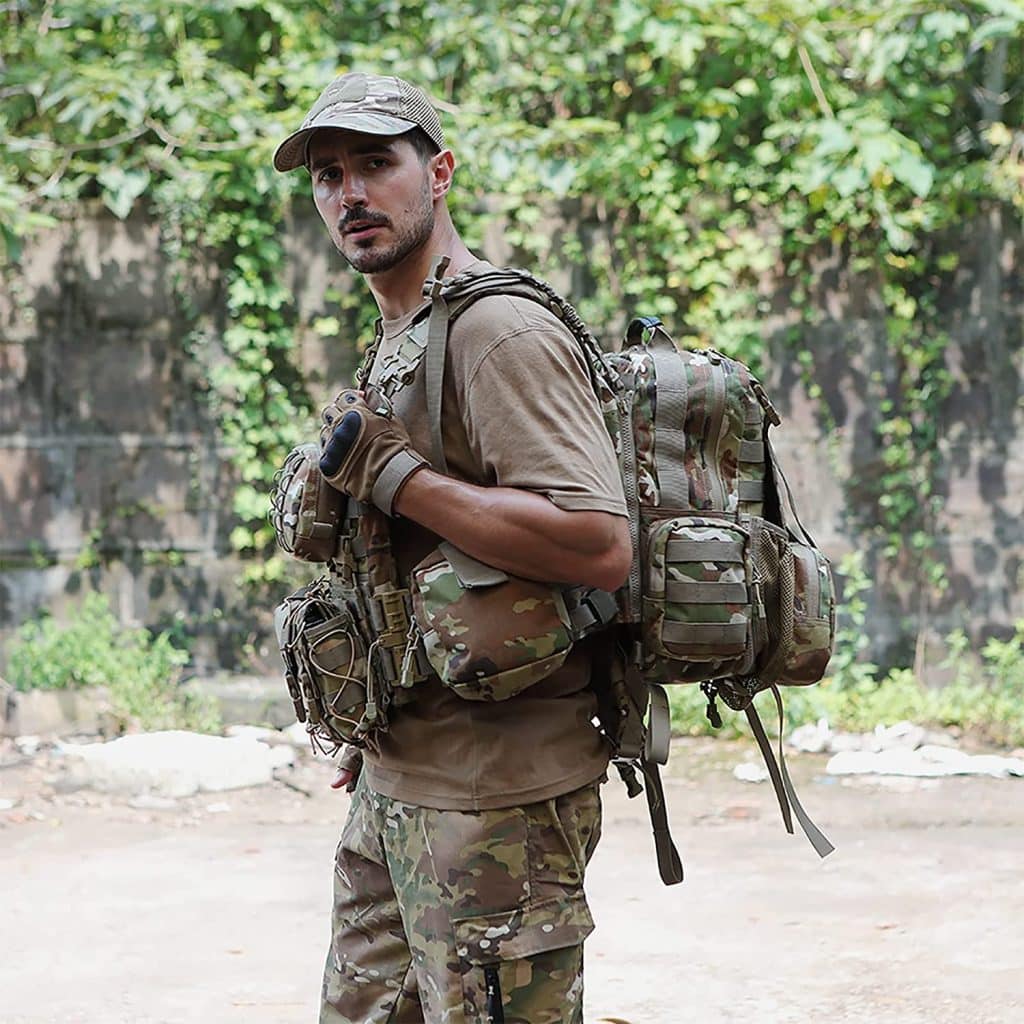
Weight
This is an important factor to consider if you want your plate carrier to be effective.
Consider this:
If you are planning on using your vest for working out, you might need one that’s heavy. However, if you’ll be using your vest for defense, like when you’re playing airsoft, you need one that’s lightweight.
If you know you’ll be moving around a lot, you should anticipate sweating a lot too. In cases where carrying heavy vests and moving around a lot are inevitable, like when you’re hiking, it’s a good idea to attach a hydration bladder to your vest. That way, you can keep yourself hydrated while reducing the risk of overheating.
Plates
Plate carriers aren’t fitted with the same kind of plates. This is why you should be extra careful when looking for the right one for you.
SAPI Plates
These are used by the U.S. military. They are particularly designed to resist high-caliber rounds.
SAPI plates are simply ceramic plates. They are covered in tough composite material to enable them to trap fragments.
Although there are different types, most of them are made of silicon carbide ceramic or boron carbide.
The protection you can get from SAPI plates is great. Unfortunately, they’re a bit heavier so wearing them around can be challenging.
Ceramic Plates
These plates are designed to shatter once they’re struck by a bullet. This means that they are only effective in stopping a single round from hitting the same area.
Ceramic plates require extra care. In fact, it’s highly recommended that you don’t drop them. And if they take a hard impact, you should get them repaired right away to ensure protection.
Polyethylene Plates
Compared with ceramic plates, these are much lighter. They are typically made of woven shield materials that help absorb impact. When a bullet hits the vest, its heat melts the material and stops the round.
Steel Plates
If steel is thick enough, it can stop ballistic rounds to a certain degree. Originally, these plates are made to halt rounds from musket rifles, but they can still be effective against today’s firearms.
MOLLE
Modular Lightweight Loadbearing Equipment is different from velcro systems. In fact, it’s far more superior than them.
With MOLLE webbing, you’ll be able to easily and quickly attach accessories, holsters, pouches, and other tactical gear pieces. Since you know where the items go, you can easily access them when needed. Compared with stuffing all the items you need into your backpack, it’s much more convenient.
Fabric
These days, one of the most affordable fabric options is the 500D Cordura Nylon. It happens to be one of the best options too.
The number refers to the fabric’s abrasive resistance nature. The higher the number, the stronger fabric is considered.
500 is a solid choice for most missions, but there are plate carriers designed with a higher fabric abrasiveness. Others can have 1000 or higher.
Stitching
Now, when assessing a plate carrier’s stitching quality, there are two things you need to take a closer look at. First is the type of thread and the other is the threading technique used.
Finding out the type of thread used on a certain plate carrier isn’t that easy. A lot of brands don’t say anything about it. They rarely advertise it too.
When it comes to threading techniques, you’ll likely encounter two options:
Bar Tack Stitching– This involves the use of a specialized machine to produce a dense series of threads. It’s quite effective in preventing tears and rips, particularly at the high-stress points of your carrier.
Single Stitching Build-Up– In comparison, this one’s cheaper because there’s no specialized machine involved. The stitching is done by running a sewing machine over the same spot several times.
Tactical Plate Carriers vs Tactical Vests
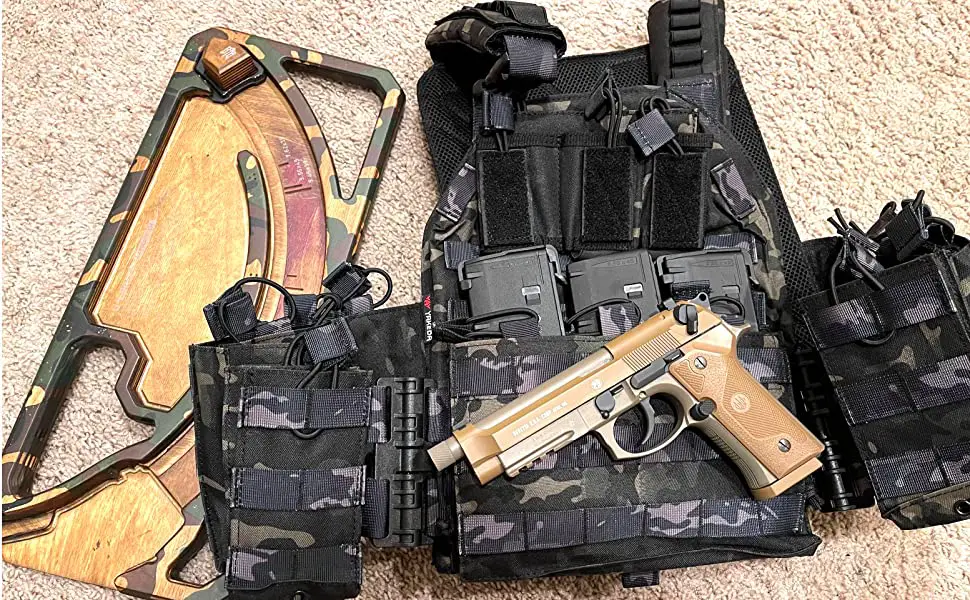
A lot of people get confused about tactical vests and plate carriers. They even use the terms interchangeably and that’s just not right. Although the two are quite similar, they still have a handful of differences.
Tactical vests are widely used in the military. Law enforcement agencies use them a lot too.
The vests are easy to take on and off because they zip down the front. They are usually designed with MOLLE or pouches all over them to hold important items, like knives, tasers, survival supplies and flashlights.
Tactical plate carriers, on the other hand, have ballistic panels. On their own, they can already feel heavy. The nice thing about them is that they distribute the weight across your body.
Like tactical vests, they are also designed with MOLLE and pouches. With so many spaces and slots, you have to be very careful about where you put your items into.
You should store items in slots that won’t make it hard for you to draw your weapons quickly.
Tactical vests are lighter. If you will be moving a lot, they won’t make you sweat that much. They won’t hold you down as well. This is something you need to consider if you often find yourself in situations that involve lots of running.
Although heavier, a tactical plate carrier offers more protection. It’s designed with protective materials and ballistic panels that can stop a bullet.
For a lot of people, the decision isn’t entirely up to them. Typically, it’s the law enforcement agency they’re working for that picks which one is best for them.
How To Set Up Your Plate Carrier
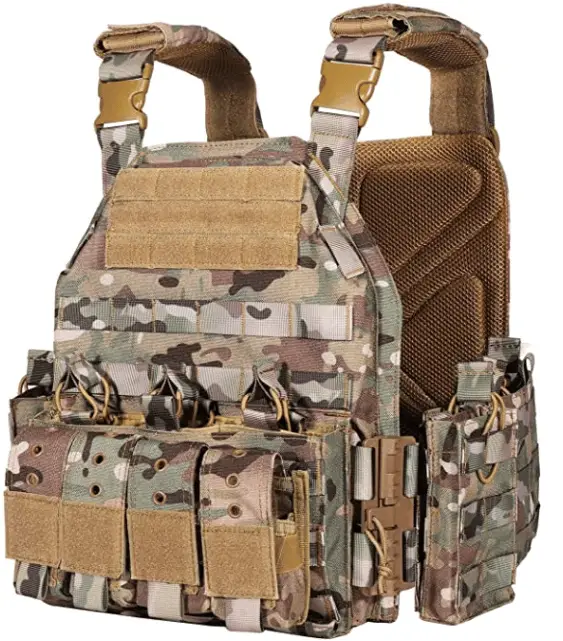
A plate carrier can only be effective if it’s worn the right way. Below is a quick guide on how to set up your plate carrier:
Know proper plate carrier sizing and fitting
When looking for the best plate carriers, it’s ideal to find one that can cover all of your vital organs. Additionally, you should also make sure that there’ll be enough room for your armor.
If you are having a hard time adjusting your plate carrier, consider asking another person to help you determine proper sizing.
Here’s a good rule to follow:
The front plate pouch of your plate carrier must sit at the width of your two fingers under your collarbone.
If there’s sagging on the back part, you can use shoulder straps to make adjustments on the rear plate pouch.
Determining your load
Ideally, your loaded pouches should be as close to your body as possible. Otherwise, you may have problems wearing your plate carrier vest properly.
There are four categories of gear typically worn with plate carriers: medical supplies, ammunition, admin, and pieces of mission-specific equipment.
The best plate carriers come with tons of slots and pouches. When determining what items to fill them with, always consider the weight you’ll be carrying.
Remember, you don’t have to fill every pouch on your plate carrier. Layering numerous pouches can increase the likelihood of snagging. Plus, it’ll make your carrier heavier.
You should also prioritize having easier access to the holster, magazines, hydration tubes and comms cables.
Keep some of your items in the center
This is a great way to balance everything and keep an even distribution of weight at the center.
It’s also ideal to put a bit more weight on the side where you are weaker. If you happen to be right-handed, you can try to carry more items on your left side. This way, you’ll be able to move freely on your right.
Ensure that your pistols are accessible
Ideally, you should value both offense and defense when wearing your plate carrier. This involves putting your pistols in places where there’s nothing that can hinder your ability to draw them out easily and quickly.
How to Clean A Plate Carrier
You should keep your plate carrier in good condition for your safety. Failure to keep it clean can cause equipment failure. Plus, it can leave you feeling uncomfortable and smelling awful.
Now, how do you keep a tactical plate carrier clean?
1. Start by brushing away any loose debris and dirt. Since you’ll be outdoors most of the time, your plate carrier can easily end up with dirt on its surface.
2. If there are areas with dried mud, you can scrape them away with a dull tool. Avoid using tools with sharp edges because they can poke holes and damage the fabric.
3. For areas that are soiled, you can create a mixture of water and liquid dish soap, and use it for spot cleaning. In case your plate carrier is heavily soiled, you can use a soft brush to gently scrub the material. Don’t use wire brushes because they can easily ruin the fibers of your plate carrier.
4. If your entire carrier needs cleaning, you may need to soak it first in a mixture of warm water and liquid laundry detergent. Using your hands, clean the carrier’s shell by agitating the water.
Avoid using a hose in rinsing, The force of the water can easily weigh down the fibers of your carrier’s fabric. It’s better to dip the entire thing in clean water until you’re able to remove all the detergent.
5. Don’t forget to dry your plate carrier in a shady spot or indoors. Try to reshape it after cleaning too.
Tips on Storing Your Plate Carrier
When you aren’t wearing your plate carrier, you need to keep it somewhere safe. That doesn’t include the trunk of your car or on top of your dirty laundry at home.
Ideally, you need to hang your plate carrier in between uses. In case you need to hang it for a long time, consider covering it with plastic first. It can help prevent dust build-up which can affect both the carrier’s fabric and performance.
And to make sure that it doesn’t get deformed during storage, invest in a good hook like this.
How Long Do Plate Carriers Last?
Believe it or not, plate carriers actually expire. It’s usually around 5 years after they’re produced. The same is true with body armor and similar safety products.
This is partly due to the chemical compounds that make up the vests. They degrade over time, lowering the effectiveness of the carrier.
There are also a couple of factors that can speed up the degradation process. Humidity and exposure to UV light are just some of them.
Take note that you have to do a regular inspection of your plate carrier. Regularly inspect it for obvious damages like separation of fabric, tears, cuts, and cracks on the surface of the plates.
Don’t forget about the panel seams. Check for folds and creases in the armor as well. These things are clear signs of improper fit. In the long run, they can make your plate carrier a lot less effective.
To ensure your safety, make it a habit to check your plate carriers for signs of both internal and external damage. You can have an expert in your field do it for you.
Now, when do you need to replace your plate carrier?
Ideally, you should look for replacements when there’s clear damage to the carrier and the plates. If you lose or gain weight, you should also consider getting a new one.
If you have been heavily using your plate carrier, you may need to replace it earlier. Daily and heavy-duty use can greatly decrease its lifespan.
The Best Plate Carriers: A Closer Look
There are tons of plate carriers on the market these days. If you aren’t careful when purchasing one, you can easily end up with a vest that’s not effective.
To help you pick the best plate carrier for you, here’s a list of the top-performing vests on today’s market:
1. GFIRE Tactical Vest
This plate carrier vest is one of the best options if your budget is tight. Despite its cheaper price, its performance and features don’t disappoint.
The GFire vest is designed for larger guys. If your size is medium to extra-large, you can fit in it perfectly. It has two strips of Velcro which you can use to adjust the plate to fit you perfectly.
The carrier plate can hold 6 x 6 and 10 by 12 side plates. Made with 1000 D Denier high-quality fabric, its build is quite impressive. In fact, it’s as nice as the more costly carriers out in the market today.
2. vAv Yakeda Outdoor Vest
You can consider this one the best plate carrier for the money.
Like most of the vests from vAv Yakeda, this one offers high quality at an affordable price
The plate carrier vest can fit a wide range of sizes since it’s highly adjustable. In fact, the waist can easily be adjusted to fit up to 50 inches.
It’s made with 900D nylon. The material is thick and durable; it won’t easily rip or tear like most cheap plate carriers on the market these days.
If you are into paintball and airsoft, don’t leave this out of your list. It can hold both soft and hard armor plates. It also has communication, map and flashlight pouches.
3. Bigfoot GTPC Quick Release Lightweight Plate Carrier
Bigfoot GTPC Quick Release Lightweight Plate Carrier has an easy-adjust system. Because of that, you can consider it a one-size-fits-all vest.
Made with 500D nylon, its built is quite good. For one, it comes with soft shoulder pads which are a great help in minimizing pain. It’s also easy to remove and put on because of its quick-release feature.
On each side, you’ll see three compartments. They are great for storing your radio or even your notebook. There’s also a zipper pouch that is big enough to accommodate a 6-inch phone.
4. Scarab Light Plate Carrier
If you are looking for the best minimalist plate carrier, Velocity Systems Scarab Light Plate Carrier is a top-notch choice. You won’t even need a manual to set it up.
It’s made of two plate bags, adjustable shoulder straps, and cummerbunds. The plate bags accept all SAPI plates.
To use them, you just need to slide the plates into the plate bag after opening the velcro flap. You can find them near the bottom part of each plate bag. To keep them high and tight, all you need to do is secure them using the velcro adjustable webbing harness.
The main body of the Scarab Light Plate Carrier is made of 500DEN Cordura nylon. It’s considered an industry standard.
The carrier is a bit bulky. That’s partly due to the padded space mesh on the inside of the plate bags. Although a bit bulky, it’s not that annoying. In fact, it adds to the comfort.
The shoulder straps of this plate carrier are quite thin. They are also designed with some foam which adds to comfort. The straps are what make this carrier a good choice for women.
5. WarTechGears Tactical Fast Vest
WarTechGears Tactical Chest Rig is an excellent option if you’re after the best lightweight plate carrier. Available in a variety of colors and sizes, it’s a highly customizable tactical vest.
To enhance your protection, you have the option to add bulletproof plates. You can put them on the front and the back.
Apart from the weight, another thing that makes this plate carrier stand out is its price. It’s budget-friendly without compromising your safety.
6. YAKEDA PHANTOM Modular Tactical Vest Plate Carrier Vest
YAKEDA PHANTOM Modular Tactical Vest Plate Carrier is a good choice if you’re into paintball, shooting, airsoft or hunting. With lots of removable pouches, you won’t easily run out of spaces to keep your ammo and mission-specific essential items.
The plate carrier is made with 1000D nylon which guarantees strength and durability. When it comes to size, it’s highly adjustable. All you have to do is adjust the shoulder and side straps as well as the bel to get that perfect fit
It accepts both steel and ceramic plates that are 1.2 inches in thickness or anything smaller than that. It accepts 10″x12″ front/backplates.
7. Shellback Tactical Banshee Elite 2.0
This is definitely one of the best plate carriers to consider if you’re looking for one that’s made for combat. It’s made with 500D Cordura nylon which is considered the most durable type of nylon around.
Although made to be tough, the plate carrier can keep your body temperature low. It has a 3D mesh to ensure ventilation and airflow.
It works well with both soft and hard body armor. It accepts plate sizes up to 10″x12″. In terms of weight, it’s just around 3lbs.
8. AR500 Plate Carrier Veritas
This plate carrier is quite light as its base layer comes in at just 1 pound and 14 ounces. Plus, it’s made of 500D Cordura nylon which means it has lots of weight capacity left. This gives you more opportunities to add necessary attachments.
Its built is quite good. If you take a closer look, you’ll see its 3D printed webbing. It’s also Bar-Tack reinforced which helps ensure that its plates won’t shift around.
Another nice thing about this plate carrier is its compatibility with most rear load-bearing systems, chest rig mounts and extensions. If you already have those things but they’re from a different company, don’t worry; you can still use them with this plate carrier.
9. MayFlower Plate Carrier
The quality of this plate carrier is quite excellent; its stitching and material appear to be top-notch.
And surprisingly, it’s actually comfortable to wear.
The APC provides a high degree of mobility without sacrificing surface area for mounting your essential pouches. In fact, it has enough space for mission essential items.
On its upper front part, you’ll find an admin pouch designed with elastic loops. There, you can safely keep pens and similar items.
In general, admin pouches are great for keeping protractors, a small GPS and even a small digital camera. They’re also the best slot to keep your extra batteries.
On its lower half, there’s an integrated pouch that can accommodate up to three M4-sized magazines.
10. VISMIX Tactical Vest Adjustable Molle Military Vest
VISMIX Tactical Vest Adjustable Molle Military Vest is made of 500D nylon material. It’s MOLLE system compatible which means you can attach more pouches and articles on the front and back. It can let you carry up to three M4 magazines right in its front magazine pouch.
With a hook and loop design, the plate carrier vest is highly adjustable. It can fit waist sizes from 36 inches to 46 inches. The adjustable shoulder straps, on the other hand, can fit anywhere between 13 inches to 26 inches.
The built is nice while the webbing is really comfortable. It’s very well-made considering its affordable price.
FAQ
Are plate carriers considered legal?
The short answer is yes. As long as you have no record of a felony conviction, you can legally purchase one. You can even do it online.
However, if you’re in Connecticut, you’ll have to do face-to-face purchases.
What color should you get?
There’s really no standard when it comes to picking a color for plate carriers.
However, since it’s mostly used in combat or situations where you need to blend well with your surroundings, pick one that will let not let you be recognized easily. If are in a green leafy area, then pick a plate carrier that’s dark green in color.
Are plate carriers bulletproof?
Yes, they are. When you find yourself in high-level threats, a plate carrier with proper plates can help you stay safe.
However, if you are facing low-level threats, you may want to use bulletproof vests instead. Compared with plate carriers, they are more comfortable to wear.
What’s the difference between a tactical and concealable vest?
A tactical vest can be worn over your shirt or uniform. It’s designed with MOLLE webbing so that you can easily attach pouches and ID panels. A concealable vest, on the other hand, is designed to be worn underneath a jacket or shirt.
What should you carry on the back of your plate carrier?
The part is usually meant to hold extra grenades and magazines, first aid medical equipment, and a hydration system.
How tight should your plate carrier be?
The straps need to be just tight enough that your plates won’t move. Don’t wear it too tightly as that can restrict your ability to move and take full, deep breaths.
Should you buy a surplus plate carrier?
There are tons of websites that sell soft body armor vests and plate carrier setups that are retired police wear. Although they are still usable, it’s not ideal to invest in them.
As mentioned earlier, plates come with expiration dates. Even if they’re still solid, they need to be retired once they’ve reached their expiration dates.
Over time, the materials and the chemicals used in making them can degrade, lowering the effectiveness of the plates in preventing penetration and reducing impact.
How long should your plate carrier be?
Ideally, it needs to be about one to three inches above the belly button. Take note that this will depend on your height as well as the size of your torso.
What size plates do you need?
Sizes vary based on the manufacturer. If you are feeling confused about the right size for you, one thing you can do is cut a piece of cardboard.
It should be the size of the plates you’re planning to buy. Hold it up your chest and see if it’s able to cover all of your vitals. It shouldn’t restrict your movements too.
When it comes to knowing the right plate carrier size for you, one good rule to remember is this:
You’ll know if you have the right size plate carrier if it can hold the dimensions of the armor plate.
This is something you should always think about when it comes to sizes. Some plate carrier manufacturers offer one-size-fits-all plate carriers while others offer the traditional sizes: small, medium and large.
